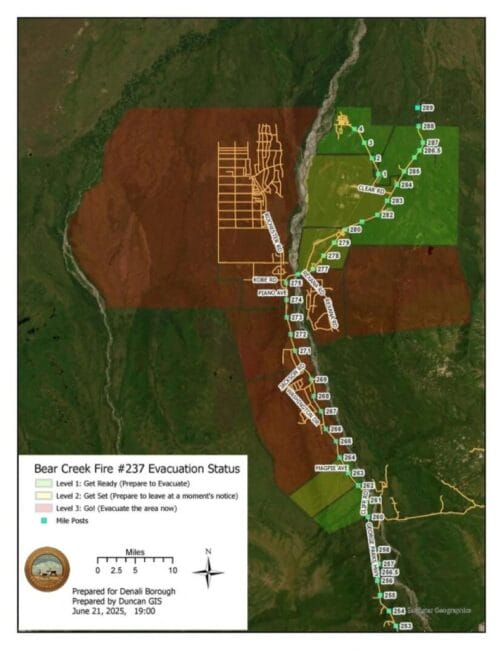Report on Paleoclimatological Findings in Alaska and Implications for Sustainable Development Goals
Introduction and Summary of Findings
A recent geological discovery in the Devil’s Canopy Cave on Prince of Wales Island, Alaska, has provided significant data for paleoclimatological research. A team led by Paul Wilcox of the University of Lapland identified a unique sediment deposit, which offers critical insights into Earth’s climate history during the last Ice Age. This research directly supports the achievement of several Sustainable Development Goals (SDGs), particularly those related to climate, environment, and scientific innovation.
- Discovery: A deposit of rounded cobbles, pebbles, and sand was found preserved within a cave system.
- Dating: Using optically stimulated luminescence, the sediments were dated to a period between 17,000 and 20,000 years ago.
- Origin: The materials are evidence of massive glacial meltwater floods, termed “Siku events,” originating from the Cordilleran Ice Sheet.
Scientific Context and Global Implications
The discovery provides a rare terrestrial record of Siku events, which were previously identified primarily through marine sediment cores in the Gulf of Alaska. These findings are pivotal for re-evaluating the mechanisms of abrupt climate change during the last Ice Age.
- Siku Events: Named from the Iñupiaq word for ice, these events involved colossal releases of freshwater and icebergs from the Cordilleran Ice Sheet into the Pacific Ocean, starting approximately 40,000 years ago.
- Comparison with Heinrich Events: Siku events in the Pacific predate the better-known Heinrich events, which were similar large-scale freshwater floods into the North Atlantic. This timeline suggests Siku events may have been a trigger or an earlier response to the same global climate driver, potentially initiating a feedback loop that destabilized the global climate system.
- Paradigm Shift: The findings challenge the traditional view of the Pacific Ocean as a passive component in global climate dynamics, highlighting its active role and prompting a re-evaluation of its influence, which has historically been under-researched compared to the North Atlantic.
Contribution to SDG 13: Climate Action
Understanding past climate dynamics is fundamental to achieving SDG 13 (Climate Action). This research provides an invaluable historical analog for the rapid environmental changes the planet is currently experiencing.
- Improving Climate Models: Data on the scale, timing, and impact of Siku events helps refine global climate models, enabling more accurate predictions of future climate scenarios.
- Understanding Tipping Points: The study of prehistoric abrupt climate shifts helps scientists identify potential tipping points and feedback loops in the Earth’s current climate system.
- Informing Policy: By providing a clearer picture of how ice sheets respond to warming and influence global systems, this research offers a scientific basis for urgent and informed climate policy and mitigation strategies.
Relevance to SDG 14 (Life Below Water) and SDG 15 (Life on Land)
The research has direct implications for understanding the resilience of ecosystems, a core component of SDG 14 (Life Below Water) and SDG 15 (Life on Land).
SDG 14: Life Below Water
- The massive influx of cold freshwater from Siku events would have drastically altered ocean circulation, salinity, and temperature in the North Pacific, impacting marine ecosystems.
- Understanding these past disruptions provides a baseline for assessing the potential impacts of modern ice melt from Greenland and Antarctica on ocean health and biodiversity.
SDG 15: Life on Land
- The discovery highlights the importance of protecting unique terrestrial environments, such as cave systems, which can act as geological “time capsules” preserving critical evidence of past environmental conditions.
- The research documents the immense power of glacial processes in shaping terrestrial landscapes, knowledge that is relevant for infrastructure planning and land management in regions affected by modern glacial retreat.
Fostering Innovation and Partnerships (SDG 9 & SDG 17)
This scientific endeavor exemplifies the principles of SDG 9 (Industry, Innovation, and Infrastructure) and SDG 17 (Partnerships for the Goals).
- Innovation (SDG 9): The use of advanced analytical techniques like optically stimulated luminescence dating was critical to the study’s success, demonstrating the role of scientific innovation in advancing our knowledge base.
- Partnerships (SDG 17): The research builds upon the work of multiple scientists and institutions, including the University of Lapland and the University of Washington. Such collaboration is essential for addressing complex, global-scale challenges like climate change.
Conclusion: Integrating Paleoclimate Research into Global Sustainability Frameworks
The discovery of Siku event sediments in Alaska is more than a geological curiosity; it is a vital contribution to the global effort to understand and combat climate change. By providing a window into Earth’s past, this research directly supports the evidence-based decision-making required to achieve the Sustainable Development Goals. Understanding the planet’s history is indispensable for navigating its future and building a resilient and sustainable world for generations to come.
SDGs Addressed in the Article
SDG 13: Climate Action
- The article’s central theme is paleoclimatology, the study of past climates. The research into “Siku events” directly contributes to understanding the mechanisms of abrupt climate change. The article explicitly states that this research helps “unravel the mystery of how Earth’s climate rapidly fluctuated thousands of years ago” and that “understanding climate changes in Earth’s history can help us prepare for the effects of future warming now.” This aligns directly with the goal of taking action to combat climate change and its impacts.
SDG 14: Life Below Water
- The research highlights the critical role of oceans in the global climate system. It discusses how “tremendous influx of cold freshwater into the North Atlantic is thought to have changed the ocean’s circulation” and how the Pacific Ocean, previously seen as “a relatively passive entity,” played a significant role. The discovery of Siku event evidence in the Gulf of Alaska underscores the connection between terrestrial ice sheets and marine environments, which is relevant to conserving and sustainably using the oceans.
SDG 15: Life on Land
- The primary discovery occurred within a terrestrial ecosystem—a cave on Prince of Wales Island. The article describes how the cave preserved sediments “like a time capsule,” protecting them from the destructive force of advancing glaciers. This emphasizes the importance of protecting unique terrestrial environments, as they can hold invaluable scientific data about Earth’s history. The discussion of the Cordilleran Ice Sheet covering “much of British Columbia and parts of Alaska” also relates to the large-scale transformation of terrestrial ecosystems.
Specific Targets Identified
Targets for SDG 13: Climate Action
-
Target 13.3: Improve education, awareness-raising and human and institutional capacity on climate change mitigation, adaptation, impact reduction and early warning.
- The article is a clear example of research that improves institutional capacity (at universities like the University of Lapland and the University of Washington) and raises awareness about the complex mechanisms of the climate system. The finding that Siku events may have triggered Heinrich events is described as “shifting a paradigm,” which fundamentally enhances the scientific community’s understanding of climate change drivers. This knowledge is crucial for improving climate models and early warning systems for future climate shifts.
Targets for SDG 14: Life Below Water
-
Target 14.a: Increase scientific knowledge, develop research capacity and transfer marine technology, taking into account the Intergovernmental Oceanographic Commission Criteria and Guidelines on the Transfer of Marine Technology, in order to improve ocean health and to enhance the contribution of marine biodiversity to the development of developing countries, in particular small island developing States and least developed countries.
- The research detailed in the article directly contributes to increasing scientific knowledge about the ocean’s role in global climate. The discovery of Siku sediments in the Gulf of Alaska and the subsequent analysis challenged the previous “Atlantic-centric” view of climate drivers. The article notes, “scientists understand the Pacific and Southern Oceans play important roles in shifting global patterns now,” and this research provides historical context for that understanding.
Targets for SDG 15: Life on Land
-
Target 15.1: By 2020, ensure the conservation, restoration and sustainable use of terrestrial and inland freshwater ecosystems and their services, in particular forests, wetlands, mountains and drylands, in line with obligations under international agreements.
- The discovery in Devil’s Canopy Cave highlights the scientific service provided by a specific terrestrial ecosystem (a mountain cave system). The article explains that such on-land evidence is rare because “The glacial ice usually destroys everything in its path.” The preservation of these sediments in the cave underscores the importance of conserving such unique geological formations, as they serve as natural archives of critical environmental data.
Indicators Mentioned or Implied
Indicators for SDG 13
-
Implied Indicator: Number of scientific publications and research projects that advance the understanding of climate change mechanisms.
- The article directly refers to the scientific studies published on this topic, such as the one in Nature and the 2020 study in Science. These publications are a direct measure of progress in strengthening the scientific knowledge base on climate change, which is essential for awareness and capacity building.
Indicators for SDG 14
-
Implied Indicator: Advancements in research methodologies and data collection concerning ocean-climate interactions.
- The article mentions specific advanced techniques used to analyze the findings, including “optically stimulated luminescence” to date sediments and “radiocarbon dating” for evidence found in the ocean. The successful application of these methods to uncover the history of the Pacific Ocean’s role in climate change serves as an indicator of developed research capacity.
Indicators for SDG 15
-
Implied Indicator: Identification and protection of terrestrial sites with high scientific and historical value.
- The article identifies Devil’s Canopy Cave as a site of immense scientific importance, calling the discovery an “unlikely discovery” that preserved a “time capsule.” While the article doesn’t state the cave is officially protected, the research itself serves as the first step in identifying the value of this ecosystem, which is a prerequisite for its conservation.
Summary Table of SDGs, Targets, and Indicators
| SDGs | Targets | Indicators (as identified in the article) |
|---|---|---|
| SDG 13: Climate Action | Target 13.3: Improve education, awareness-raising and human and institutional capacity on climate change mitigation, adaptation, impact reduction and early warning. | Implied: The publication of research in scientific journals (e.g., Nature, Science) that shifts paradigms and improves the fundamental understanding of past and future climate change. |
| SDG 14: Life Below Water | Target 14.a: Increase scientific knowledge, develop research capacity and transfer marine technology… in order to improve ocean health. | Implied: The use of advanced dating methods (optically stimulated luminescence, radiocarbon dating) to analyze marine and terrestrial evidence, leading to new knowledge about the Pacific Ocean’s role in global climate. |
| SDG 15: Life on Land | Target 15.1: Ensure the conservation, restoration and sustainable use of terrestrial and inland freshwater ecosystems and their services. | Implied: The identification of unique terrestrial ecosystems (like Devil’s Canopy Cave) that serve as invaluable “time capsules” for scientific data, highlighting their value and the need for their conservation. |
Source: ktoo.org






